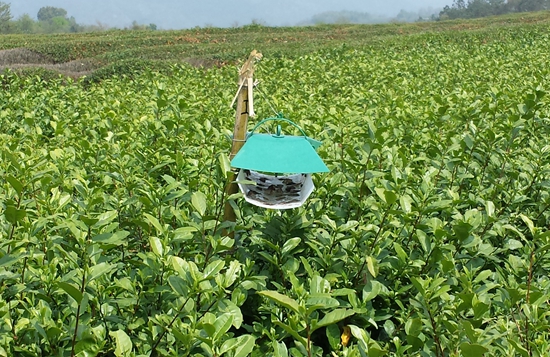分享到
CAAS researchers found the mechanism of the population genetic differentiation of Ectropis obliqua Prout
Researchers led by Prof. Xiao Qiang at the Tea Research Institute (TRI) found that the tea geometrid (Ectropis obliqua Prout, Lepidoptera: Geometridae) from the different geographic population in China existed obvious genetic differentiation. This research finding has been published on PLoS ONE on June 10th, 2014.
Ectropis obliqua Prout is a dominant chewing insect endemic in most tea-growing areas in China. It infests thousands of hectares a year, especially in the key conventional green tea producing area, including Zhejiang, Jiangsu and Anhui Provinces. E.obliqua nucleopolyhedrovirus (EoNPV) is an effective natural biological agent that has been successfully developed as a bio-insecticide in China for the control of the tea geometrid. Preliminary research found that the susceptibility to this host-specific virus was different for the tea geometrid from the different population. The virulence of the virus to the susceptible population was more than 700 times to the insensitive population.

To understand and detect divergence in different populations of E. obliqua, we collected seventeen populations from eight main tea-producing provinces of China. With different geographic populations as materials, we cloned and sequenced the COI gene of these populations, compared homology and polymorphism of the sequence. The NJ and MP phylogenetic trees showed that seventeen populations of E. obliqua had divided into two distinct clades. Further inheritance analyses using reciprocal single-pair mating demonstrated an abnormal F1 generation with an unbalanced sex ratio and the inability to produce fertile eggs (or any eggs) through F1 self-crossing. Compared with the self-cross controls, the F1 generations from cross-breeding the populations in the same clade developed and produced normal progenies.
These data revealed a certain degree of reproductive isolation between the clades, and indicated that the increase of population differentiation. The findings would be a solid foundation for elucidating whether there is a closely related species or cryptic species within E. obliqua and finding out the uneven distribution of the groups. Meanwhile, the results of this study could provide evidence for scientific and effective when using EoNPV to control tea geometrid.
More details are available the links bellow:
http://www.plosone.org/article/info:doi/10.1371/journal.pone.0099373.
Ectropis obliqua Prout is a dominant chewing insect endemic in most tea-growing areas in China. It infests thousands of hectares a year, especially in the key conventional green tea producing area, including Zhejiang, Jiangsu and Anhui Provinces. E.obliqua nucleopolyhedrovirus (EoNPV) is an effective natural biological agent that has been successfully developed as a bio-insecticide in China for the control of the tea geometrid. Preliminary research found that the susceptibility to this host-specific virus was different for the tea geometrid from the different population. The virulence of the virus to the susceptible population was more than 700 times to the insensitive population.

To understand and detect divergence in different populations of E. obliqua, we collected seventeen populations from eight main tea-producing provinces of China. With different geographic populations as materials, we cloned and sequenced the COI gene of these populations, compared homology and polymorphism of the sequence. The NJ and MP phylogenetic trees showed that seventeen populations of E. obliqua had divided into two distinct clades. Further inheritance analyses using reciprocal single-pair mating demonstrated an abnormal F1 generation with an unbalanced sex ratio and the inability to produce fertile eggs (or any eggs) through F1 self-crossing. Compared with the self-cross controls, the F1 generations from cross-breeding the populations in the same clade developed and produced normal progenies.
These data revealed a certain degree of reproductive isolation between the clades, and indicated that the increase of population differentiation. The findings would be a solid foundation for elucidating whether there is a closely related species or cryptic species within E. obliqua and finding out the uneven distribution of the groups. Meanwhile, the results of this study could provide evidence for scientific and effective when using EoNPV to control tea geometrid.
More details are available the links bellow:
http://www.plosone.org/article/info:doi/10.1371/journal.pone.0099373.
By Zhang Guihua
13588127660@163.com
13588127660@163.com
Latest News
-
 Apr 18, 2024Opening Ceremony of the Training Workshop on Wheat Head Scab Resistance Breeding and Pest Control in Africa Held in CAAS
Apr 18, 2024Opening Ceremony of the Training Workshop on Wheat Head Scab Resistance Breeding and Pest Control in Africa Held in CAAS -
 Apr 03, 2024IPPCAAS Co-organized the Training Workshop on Management and Application of Biopesticides in Nepal
Apr 03, 2024IPPCAAS Co-organized the Training Workshop on Management and Application of Biopesticides in Nepal -
 Mar 28, 2024Delegation from the School of Agriculture and Food Science of University College Dublin, Ireland Visit to IAS, CAAS
Mar 28, 2024Delegation from the School of Agriculture and Food Science of University College Dublin, Ireland Visit to IAS, CAAS -
 Mar 25, 2024Director of World Food Prize Foundation visited GSCAAS
Mar 25, 2024Director of World Food Prize Foundation visited GSCAAS -
 Mar 20, 2024Institute of Crop Sciences (ICS) and Syngenta Group Global Seeds Advance Collaborative Research in the Seed Industry
Mar 20, 2024Institute of Crop Sciences (ICS) and Syngenta Group Global Seeds Advance Collaborative Research in the Seed Industry
